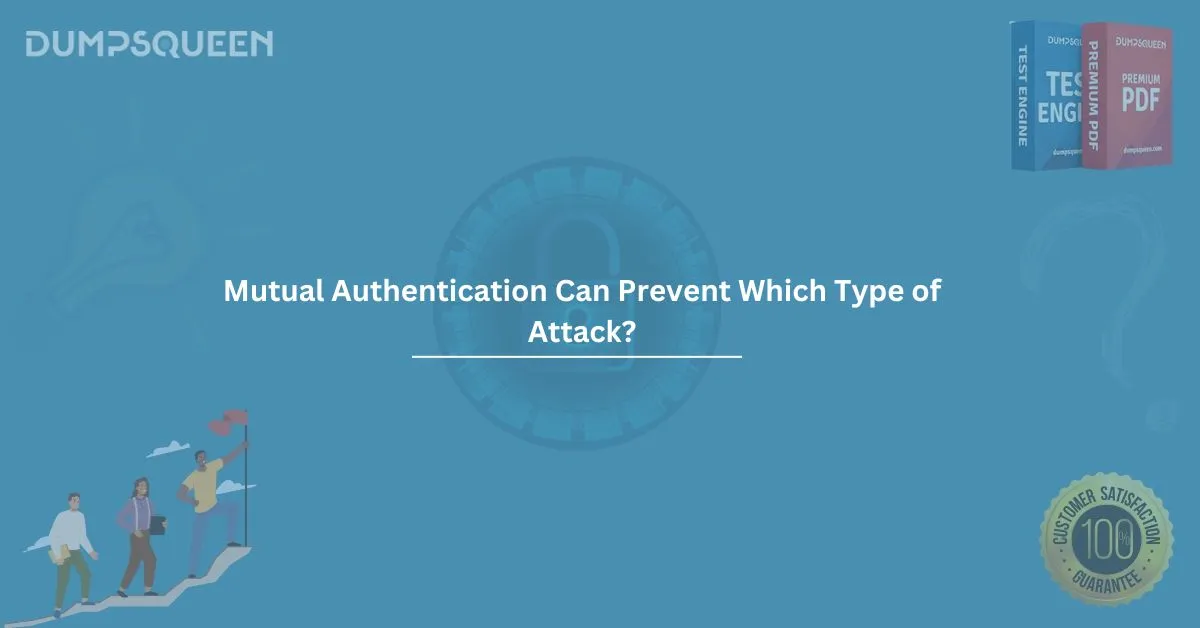In the ever-evolving landscape of cybersecurity, one of the critical security measures is mutual authentication. It plays a significant role in establishing trust between two parties—typically a client and a server—before data is exchanged. In this article, we will explore how mutual authentication can prevent which type of attack, its mechanisms, benefits, and why it's a must-know concept for IT certification exams.
Whether you're preparing for CompTIA Security+, CISSP, CEH, or other security certifications, understanding mutual authentication is crucial. At DumpsQueen, we make sure our candidates are fully equipped with real-world concepts and exam-focused knowledge.
What Is Mutual Authentication?
Mutual authentication—also known as two-way authentication—is a security mechanism where both entities in a communication session validate each other’s identities before data transfer begins. Unlike one-way authentication (where only one side authenticates), mutual authentication ensures that both the client and server are verified.
This is commonly used in:
- SSL/TLS connections
- VPN connections
- Secure APIs
- Mobile banking apps
- IoT device communication
How Does Mutual Authentication Work?
Mutual authentication typically involves the use of digital certificates, public key infrastructure (PKI), and encrypted channels like TLS/SSL. Here’s how it works in brief:
- Client sends a request to connect to the server.
- Server sends its certificate to the client.
- Client validates the server certificate using a trusted Certificate Authority (CA).
- Client presents its own certificate to the server.
- Server validates the client’s certificate.
- If both validations succeed, the communication proceeds in a secure, encrypted manner.
Mutual Authentication Can Prevent Which Type of Attack?
Let’s address the key focus of this blog: “mutual authentication can prevent which type of attack?”
The primary type of attack that mutual authentication prevents is the Man-in-the-Middle (MITM) attack.
What Is a Man-in-the-Middle Attack?
A MITM attack occurs when a malicious actor intercepts or alters communication between two parties without their knowledge. The attacker impersonates both ends to extract sensitive data, inject malware, or alter transmitted messages.
How Mutual Authentication Prevents MITM Attacks
By requiring both parties to verify their identities using digital certificates, mutual authentication makes it nearly impossible for an attacker to impersonate either side. Here's why:
- An attacker would need to possess a valid certificate and private key from a trusted CA, which is very hard to achieve.
- Any attempt to spoof either the client or server will fail validation, terminating the session immediately.
- All communications occur over encrypted channels, adding another layer of defense.
So, in summary:
Mutual authentication can prevent Man-in-the-Middle (MITM) attacks effectively.
Other Threats Mitigated by Mutual Authentication
While MITM attacks are the main concern, mutual authentication can also help reduce the risks of:
- Phishing attacks: The server must present a valid certificate, so spoofed sites are easier to detect.
- Replay attacks: Encrypted channels and timestamping help mitigate replayed sessions.
- Impersonation attacks: Attackers can’t impersonate legitimate users or systems without proper credentials.
When Is Mutual Authentication Used in Practice?
Here are real-world scenarios where mutual authentication is actively used:
1. Banking Applications
Mobile banking apps and web platforms use mutual authentication to secure transactions. This ensures that clients connect to the official bank server—not a fake version.
2. Virtual Private Networks (VPNs)
VPNs often use mutual authentication to verify both the user's device and the VPN server, securing remote access to sensitive networks.
3. IoT Devices
Smart homes, medical devices, and industrial sensors use mutual authentication to ensure device integrity and prevent rogue device access.
4. Enterprise APIs
APIs connecting different systems or third-party applications require mutual authentication to ensure secure integration.
Benefits of Mutual Authentication
- Prevents MITM and spoofing
- Ensures bidirectional trust
- Protects sensitive transactions
- Boosts compliance (HIPAA, PCI-DSS, etc.)
- Improves overall system integrity
Challenges and Limitations
Like all technologies, mutual authentication isn’t without its challenges:
- Complex configuration: Requires setting up a PKI system and managing certificates.
- Scalability: More difficult to manage as the number of users and services grows.
- User experience: Requires more steps in the handshake process, which could affect performance.
However, with robust certificate management and automation tools, these challenges can be mitigated.
Why Certification Candidates Must Understand This
If you're preparing for security certifications with DumpsQueen, you’ll likely encounter questions around this topic. Exams like:
- CompTIA Security+
- Certified Ethical Hacker (CEH)
- CISSP
- CISM
- Network+
...frequently test your knowledge of authentication mechanisms, including mutual authentication and its real-world implications.
Best Practices for Implementing Mutual Authentication
If you're an IT professional or student, here’s what to keep in mind when implementing mutual authentication:
- Use trusted Certificate Authorities (CAs) to issue certificates.
- Regularly rotate and renew certificates to avoid expiration issues.
- Use strong encryption algorithms (like AES, RSA, etc.) in combination with mutual authentication.
- Log all authentication attempts and set up intrusion detection in case of certificate failures or unauthorized access.
- Educate users and developers about certificate pinning and the dangers of accepting invalid certificates.
Why DumpsQueen Recommends Learning Mutual Authentication
At DumpsQueen, our goal is to ensure every candidate has real-world knowledge + exam readiness. Understanding how mutual authentication can prevent which type of attack not only helps in exams but also in your IT career. Our study materials, practice questions, and dumps cover all core areas including:
- Authentication techniques
- Encryption protocols
- Attack vectors
- Network security fundamentals
With us, you're not just memorizing—you’re understanding.
Conclusion
So, to summarize:
Mutual authentication is one of the most effective methods to prevent Man-in-the-Middle attacks and strengthen overall system trust.
It works by requiring both parties to validate each other using digital certificates, creating a two-way trust system.
If you're preparing for a certification or actively working in cybersecurity, mastering mutual authentication is a must. And with DumpsQueen's expert resources, you're already ahead of the game.
Sample Exam Questions (MCQs)
1. Mutual authentication can prevent which type of attack?
A. Brute force attack
B. Denial of Service attack
C. Man-in-the-Middle attack
D. Dictionary attack
Correct Answer: C. Man-in-the-Middle attack
2. In mutual authentication, which of the following must be verified by both client and server?
A. Password
B. IP address
C. Digital certificate
D. Username
Correct Answer: C. Digital certificate
3. Which security protocol often uses mutual authentication for secure communication?
A. HTTP
B. FTP
C. TLS/SSL
D. SMTP
Correct Answer: C. TLS/SSL
4. What is the main purpose of mutual authentication in a VPN?
A. To reduce bandwidth
B. To monitor user activities
C. To verify both the VPN client and server
D. To encrypt data after transfer
Correct Answer: C. To verify both the VPN client and server




